|
|
|
|
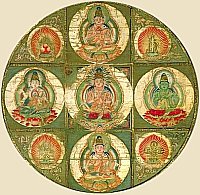 
Number Five in Buddhist Traditions
OVERVIEW. The number five holds tremendous significance in nearly all Buddhist traditions. It refers to the Five Colors (Goshiki 五色), the Five Senses (Goshiki 五識), the Five Wisdoms (Gochi 五知), the Five Buddha (Gobutsu 五佛), and a host of other important philosophies. The number five is intimately associated with the Chinese theory of the Five Elements (see below), a concept underpinning the Zodiac Calendar, the latter serving as the preeminent calendar of old-world Asia. Indeed, China’s five-element theory is generally thought to predate Buddhism, but in later centuries its influence is dressed predominantly in Buddhist garb. There are dozens of concepts associated with the number five. This page presents only a small sampling.
 FIVE ELEMENTS & YIN-YANG DUALISM FIVE ELEMENTS & YIN-YANG DUALISM
<quoted from TAO, The Watercourse Way by Alan Watts> The five elements 五行 (Jp = Gogyō, Ch = Wu Hsing) are wood, fire, earth, metal, and water. In China, the first celebrated exponent of the five-element theory was Tsou Yen (350 - 270 BC). The five energies were symbolized as (1) wood, which as fuel gives rise to (2) fire, which creates ash and gives rise to (3) earth, which in its mines contains (4) metal, which (as on the surface of a metal mirror) attracts dew and so gives rise to (5) water, and this in turn nourishes (1) wood. This is called hsiang sheng (相生), or the “mutually arising” order/cycle of the fundamental forces. These forces were also arranged in the order of “mutual conquest” (相勝) -- likewise read hsiang sheng, but sheng is a different ideogram -- in which (1) wood, in the form of a plow, overcomes (2) earth, which, by damming and constraint, conquers (3) water which, by quenching, overcomes (4) fire which, by melting, liquifies (5) metal, which, in turn, cuts (1) wood. <end quote Alan Watts>
In China, the five elements were combined with the binary Yin-Yang system -- Yin 陰 (Jp = in) and Yang 陽 (Jp = yō) -- to obtain ten “alternative” readings for the ten stems of the Zodiac Calendar. See Zodiac Page for details. The introduction of Esoteric Buddhism to Japan, however, involved a different set of five elements, to which a six element was added. See Six Elements (this page) for more details.
- Earth
- Water
- Fire
- Air (or Wind)
- Space (or Void)
- Mind (spiritual consciousness or perception)

GOSHIKI 五色, GOSEISHOKU 五正色. Lit. = Five Primary Colors. These five colors are also associated with the five elements, the five compass directions, the seasons, five compound colors, and a host of others attributes.
- Blue = East, Green (compound color), Spring, Wood, Meditation
- Red = South, Scarlet (compound color), Summer, Fire, Zeal
- White = West, Crimson (compound color), Autumn, Wind, Faith
- Black = North, Purple (compound color), Winter, Water, Wisdom
- Yellow = Center, Brown (compound color), Earth, Memory
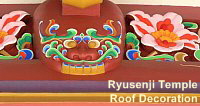 There are different variations among the different sects. Another common grouping is shown below. There are different variations among the different sects. Another common grouping is shown below.
- Green/Blue = Earth
- Yellow = Water
- Red = Fire
- White = Wind, Air
- Black = Space, Void
五色とは青・黄・赤・白・黒で梵語で言う地・水・火・風・空
In later centuries, the five were associated with five parts of the body. These attributes vary among different sects in different nations. < source Flammarion Iconographic Guide: Buddhism, p. 311) >
- between eyebrows (blue, dark, or black)
- heart (red)
- navel (white)
- hips (yellow)
- top of skull (bright)
Color of Monk’s Robe. Robe = Noue (Nōe) 衲衣 or 納衣. Based on Buddhist law, monks were forbidden to wear robes using any single primary color, but this was permitted if the robe’s fabrics were made of patchwork pieces from various rags (discarded clothing). A robe made with five fabrics of different color is called Gonoe 五衲衣 (Gonōe). One made from many more colors is called Hyakunoue 百衲衣 (Hyakunōe), literally “100-colored robe.” See the Drapery Page for more details on robes.

GOSHIKI NO ITO 五色の糸, Five-Colored Cord (String, Rope)
During the Heian period, the tradition of hanging a scroll of Amida Nyorai in front of a dying person was established. A five-colored cord was attached to the scroll and extended into the hands of the dying person. According to Pure Land believers, if the dying person held firmly to the cord during the final moments of life, s/he was assured direct passage to Amida's Western Paradise (Jp. = Gokuraku or Pure Land).
Above Photo: Modern Replica of 12th-13th Century Painting
Amida Buddha Coming over the Mountains. Replica adds the Five-Colored Cord
Photo courtesy Ryukoku University (J-site)

GOSHIKI UN 五色雲, Five-Colored Cloud. The Senju Kannon 千手観音 (1000-Armed or 1000-Handed Kannon) is often portrayed with a five-colored cloud in one hand or riding atop a five-colored cloud. The Bosatsu who attend Amida Nyorai are also sometimes shown on clouds of five colors. See Bosatsu on Clouds for more details and photos.
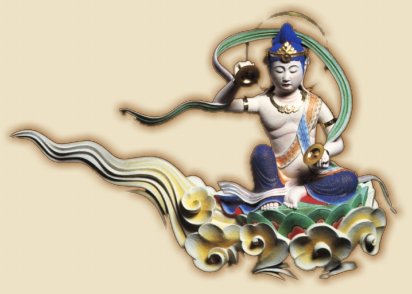
Bosatsu on Clouds 雲中供養菩薩
Modern Reconstruction, Byōdō-in Temple in Kyoto. Photo 日本の美をめぐる, No. 45

China, Tang Dynasty, Painting 9th century. Bodhisattva, Color on Silk. L = 195 cm, W = 28 cm
From China's Dunhuang Excavation 莫高窟蔵経洞. Photo Courtesy Tokyo Nat’l Museum.
Painting on loan from Museum Guimet (France).

GOSHIKI SUI 五色水. Five-Colored Water. Every year on April 8th in Japan, a ceremony called Kanbutsu-e 潅仏会 is held to commemorate the Historical Buddha's birthday. A small statue of the Buddha is typically sprinkled with hydrangea tea or with scented water called Goshiki Sui.
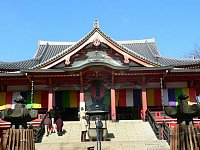 GOSHIKI FUDŌ 五色不動. 5-Colored Fudō Temples. Below text courtesy Gabi Greve. In Japan’s Edo Period (1603 to 1867), there were five temples with five identical statues of Fudō Myō-ō called the Goshiki Fudō (Five-Colored Fudo Temples) to secure supernatural power for the protection of Edo (Tokyo) city from the north. The stautes differed only in the color of the eyes. The place names Meguro (black-eyed) and Mejiro (white-eyed) are still used in Tokyo today. The red-eyed was Komagome, the yellow-eyed Komatsugawa, and the green-eyed Setagaya. GOSHIKI FUDŌ 五色不動. 5-Colored Fudō Temples. Below text courtesy Gabi Greve. In Japan’s Edo Period (1603 to 1867), there were five temples with five identical statues of Fudō Myō-ō called the Goshiki Fudō (Five-Colored Fudo Temples) to secure supernatural power for the protection of Edo (Tokyo) city from the north. The stautes differed only in the color of the eyes. The place names Meguro (black-eyed) and Mejiro (white-eyed) are still used in Tokyo today. The red-eyed was Komagome, the yellow-eyed Komatsugawa, and the green-eyed Setagaya.
GOSHIKI 五識. The Five Senses. <Source Soothill> The Five Parijñānas (Skt.), the five perceptions or cognitions, ordinarily those arising from the five senses:
- form and color
- sound
- smell
- taste
- touch
One of earliest remaining Mahayana texts (circa 554 AD), Awakening of Faith (起信論), has a different set of five.
- 業識 initial functioning of mind under the influence of the
original 無明 unenlightenment or state of ignorance
- 轉識 the act of turning towards the apparent object for its observation
- 現識 observation of the object as it appears
- 知識 the deductions derived from its appearance
- 相續識 the consequent feelings of like or dislike, pleasure or pain,
from which arise the delusions and incarnations
< Adapted from William Edward Soothill, A Dictionary of Chinese Buddhist Terms, ISBN 81-215-1145-3 >

 GODAI MYOU-OU 五大明王 GODAI MYOU-OU 五大明王
Five Great Kings, Five Wisdom Kings
In Esoteric Buddhism, there are the Five Great Kings of Magic Science. Click here for details about these five, who represent the five directional elements.
 GOCHI NYORAI 五智如来 GOCHI NYORAI 五智如来
Five Buddha of Wisdom, Five Buddha of Meditation
Five Jina | Five Tathagata. Click here for details.
Especially important to the Shingon and Tendai sects of Esoteric Buddhism, these five Buddha (or Tathagata, Nyorai) are eminations of the absolute Buddha. They appear frequently in the Japanese Mandala. They embody five fundamental wisdoms -- wisdom against anger, envy, desire, ignorance, and pride -- to help us break free from the cycle of death and rebirth, or the Six States of Existence (i.e., the cycle of suffering, Sanskrit = samsara).
 GORIN 五輪 or GORINTOU 五輪塔 GORIN 五輪 or GORINTOU 五輪塔
FIVE-ELEMENT STUPA, FIVE-TIER PAGODA
Literally five-ring or five-element pagoda. Also called Gorinsekitou (五輪石塔), Houkaitou (法界塔), Gorintouba (五輪塔婆), or Gogedatsurin (五解脱輪). Each piece in the five-story pagoda (Sanskrit = stupa) corresponds to one of five elements. The bottom story is square and corresponds to the earth ring (Japanese = Chirin 地輪). Next is the spherical water ring (Japanese = Suirin 水輪), surmounted by the triangular ring of fire (Japanese = Karin 火輪). Above this is a reclining half-moon shape (Japanese = Fuurin 風輪), representing the wind, and topmost is the gem-shaped ring of space (Japanese = Kuurin 空輪). Click here for many more details.
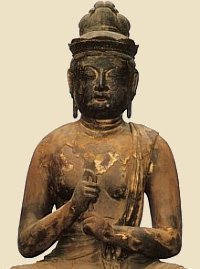 SIX ELEMENTS 六界, Esoteric Buddhism SIX ELEMENTS 六界, Esoteric Buddhism
In Esoteric Buddhism, the five worldly elements (earth, water, fire, air/wind, and space/void) differ somewhat from China’s five elements. The five elements of Esoteric Buddhism are combined with one additional element, the MIND, for a total of six. Statues or paintings of Dainichi Buddha, the central deity of Esoteric Buddhism in Japan, often portray Dainichi with a characteristic hand gesture called the Mudra of Six Elements (Jp. = 智拳印 Chiken-in) in which the index finger of the left hand is clasped by the five fingers of the right. This mudra symbolizes the unity of the five worldly elements with a six element, spiritual consciousness. In the Mandala artform, which is of special importance to Japan’s Esoteric sects (Shingon, Tendai), the five elements are considered inanimate (this equates to the Garbhadhatu or Womb World Mandala). Only by adding the sixth element -- mind, perception, or spiritual consciousness -- do the five become animate. This equates with the Vajradhatu or Diamond World Mandala. Phrased differently, there is “unity” only when the sixth element is added. Without the sixth element, ordinary eyes see only the differentiated forms or appearances.
- Earth
- Water
- Fire
- Air (or Wind)
- Space
- the MIND (spiritual consciousness or perception)

FIVE DESTINATIONS. 五趣 or 五惡趣 or 五道. The Five Realms (Skt. = Gati; lit. destinations or destinies). The five are beings in hell, hungry ghosts, animals, human beings, and devas. In Japan, there are typically six gati 六道, in which case the Asura are added. For more on all five (six), please see Six Realms of Transmigration.
SIX REALMS OF SAMSARA. 六趣 or 六道眾生 or 六道 (lit. “Six Roads”). In Japan’s Mahayana traditions, all sentient beings are born into one of the six realms, for all are trapped in the cycle of suffering (Skt. = Samsara ), the cycle of life and death, or the wheel of life as the Tibetans call it. All beings within the six realms are doomed to death and rebirth in a recurring cycle over countless ages -- unless they can break free from desire and attain enlightenment. Upon death, all beings are reborn into a lower or a higher realm depending on their actions while still alive. For more on the Six Realms, click here. The six are:
- Beings in Hell, Jigokudō 地獄道 (Skt. = Naraka gati)
- Hungry Ghosts, Gakidō 餓鬼道 (Skt. = Preta gati)
- Animals, Chikushōdō 畜生道 (Skt. = Tiryagyoni gati)
- Ashura, Ashuradō 阿修羅道 (Skt. = Asura gati)
- Humans, Nindō 人道 (Skt. = Manusya gati)
- Deva, Tendō 天道 (Skt. = Deva gati)
After these six states come the four highest states, the "Four Noble Worlds." These final four stages can only be achieved through deliberate effort -- in contrast, our movement in the six lower states is passive and blinded by false understanding. Thus, there are nine states from Hell to Bodhisattva (Bosatsu). The highest level, the tenth level, is Buddhahood. See Ten Worlds for details.
- Sravaka Arhat (Jp. = Shōmon 声聞)
- Pratyeka Buddha (Jp. = Engaku 縁覚)
- Bodhisattva (Jp. = Bosatsu 菩薩)
- Buddha (Jp. = Hotoke 仏, Nyorai 如来)
SIX JIZO, SIX KANNON. In Japan, groupings of six Jizo Bosatsu statues (one for each of the Six Realms) are quite common and often placed at busy intersections or oft-used roads to protect travelers and those in "transitional" states. Jizo also often carries a staff with six rings, which he shakes to awaken us from our delusions -- the rings likewise symbolize the six states of existence. In Japan, Kannon Bosatsu is also shown in six basic forms to protect people in all six realms of rebirth (reincarnation).
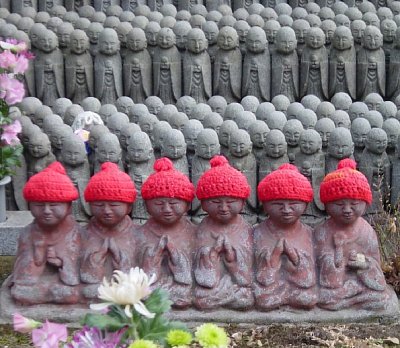
Six Jizo Statues at Hase Dera in Kamakura, Japan

LEARN MORE ABOUT NUMBER FIVE
- JAANUS. Japanese Architecture & Art Net Users System. Compiled by the late Dr. Mary Neighbour Parent; covers both Buddhist and Shinto deities in great detail and contains over 8,000 entries.
- A Dictionary of Chinese Buddhist Terms. With Sanskrit & English Equivalents. Plus Sanskrit-Pali Index. By William Edward Soothill & Lewis Hodous. Hardcover, 530 pages. Published by Munshirm Manoharlal. Reprinted March 31, 2005. ISBN 8121511453.
- Butsuzō-zu-i 仏像図彙, the “Collected Illustrations of Buddhist Images.” Published in 1783 (Genroku 元禄 3). Hundreds of pages and drawings, with deities classified into approximately 80 categories. Modern-day reprints are available at this online store (J-site).
- Digital Dictionary of Chinese Buddhism (C. Muller; login "guest")
- Buddhism: Flammarion Iconographic Guides, by Louis Frederic, Printed in France, ISBN 2-08013-558-9, First published 1995. A highly illustrated volume, with special significance to those studying Japanese Buddhist iconography. Hundreds of accompanying images/photos, both B&W and color. A useful addition to your research bookshelf.
- A History of Japanese Religion. Edited by Kazuo Kasahara. Kosei Publishing Company, 2002. Translated by Paul McCarthy and Gaynor Sekimori. 648 pages. Sixteen distinguished experts on Japanese religion approach the topic from modern perspectives. Topics range from prehistoric times up until the early postwar years. Click here to read review of book by scholar Paul L. Swanson.
- See Bibliography for our complete list of resources on Japanese Buddhism, or visit any site page and scroll to the bottom for detailed resources on that specific deity or topic.
WEB RESOURCES

First Published Sept. 11, 2006
|
|